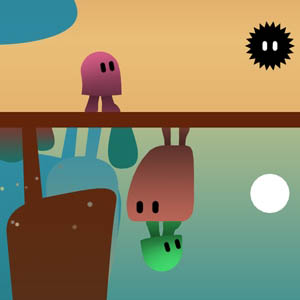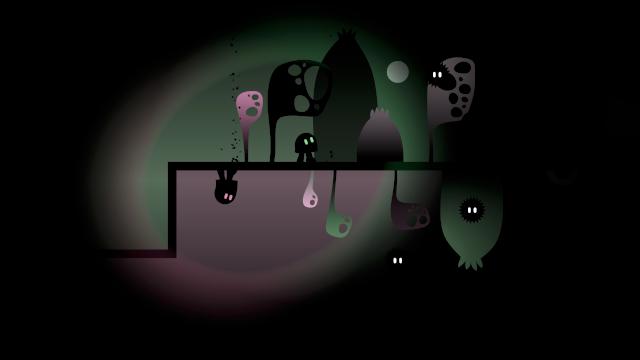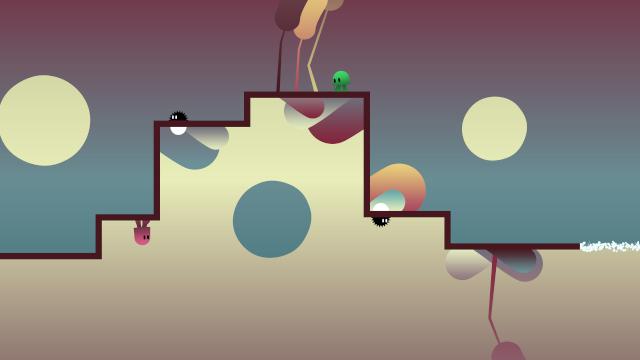
Imagine you’ve pulled apart one of those little plastic antibiotic capsules, but instead of finding penicillin inside, each of those halves sprouts a little pair of legs. That’s Ibb and Obb. Two little domes with legs, named after characters in a Jasper Fforde novel, one fractionally taller than the other, one pink, one green, but apart from that, identical.
Our heroes are then plunged into, at first glance, a simple cutesy co-op (local or online) side-scrolling platform game, offering nothing more complex than having to jump off each other’s heads to climb up a large step, but before long its deviousness is revealed. The line that divides the screen at all times, isn’t just the floor for the top half of the screen, it’s also an upside down floor for the BOTTOM half of the screen. So while Ibb (or Obb) is walking above the line, Obb (or Ibb) could be walking below it, as if he is walking on the ceiling.
One of the benefits of this dual world, is that the black spiky enemies that patrol either side are mirrored by a vulnerable glowing ball on the opposite. Ibb (or Obb) can only pass the enemies on the top side, if Obb (or Ibb) jumps on their glowy balls on the under-side. This is where the co-operative element to the game starts to come into play.

Dotted around at key locations are portals between the top and bottom worlds, and yes, I used that word deliberately. If you have played Portal, then you’ll actually have a slight head start in how to approach some of these puzzles. For example, you may find that you need to do a particularly high jump on the top-side, but no way to get up there. What you actually have to do is jump off a “high” ledge on the under-side, fall through a portal, and the momentum will carry you up onto the ledge you couldn’t reach before.
Later on, bounce pads that only affect the person on the opposite side, and coloured portals that only allow Ibb (or Obb) – sorry this will never get old – to pass through, add even more challenge to the game. You will frequently find yourselves staring at the screen wondering how on earth you can possible get to where you need to be, but with some experimentation, some messing about, and maybe some lucky mistakes, things will click into place. And when they do, you’ll feel really smug about it.
The actual platforming controls, at least for the co-operative play, are very precise, with just the right amount of ‘floatiness’ – when you fail it’s because you misjudged a jump, or took the wrong trajectory, never because the controls let you down. Anyway, any time you die, you are reset maybe half a screen back, and with no limited number of lives, this removes almost all frustrations in this area. This also opens up some emergent gameplay – I often found myself deliberately shoving my daughter off a platform to die on a spiky monster, or she would deliberately jump at the wrong time just to wind me up. Moments like this are great fun and really add an extra element to the game.
Again similarly to Portal 2, the developers have built in a non-verbal method of communicating with each other if you are playing online. In Valve’s classic, you could mark part of the scenery to give your partner a hint or a message. Here, you can use your right stick to draw a trail on the screen, to give your partner a nudge in the right direction, or to track the portal jump solution your friend might not have noticed.

It’s not all positive though. The developers saw fit to add a single player mode, that has you attempting to control Ibb (or Obb) and Obb (or Ibb) with the left and right sticks. The downside of this is having to rely on using the old fashioned “press up to jump” control mechanism which, when added the fact that one of your characters is often in the upside-down world, rapidly becomes very tricky indeed. Still, there is a trophy for completing the game in single player mode, so at least the developers have acknowledged that challenge.
Finally, a review of the game cannot be considered complete without a mention of the graphics. They are simplistic, sharp, and sort of modern-retro. The palette changes as you progress through the game, but the top and bottom worlds are always very distinct. At first I wasn’t sure if they were too simplistic, but as soon as they saw them, my wife and daughter fell in love with the cute style, which totally adds to the game’s charm.
So how to sum up Ibb (or Obb) and Obb (or Ibb)? (That was the last time, honest). Actually, by total coincidence, the last word of the previous two paragraphs sums it up perfectly – “challenge” and “charm”. Might be worth making sure you have someone to play with first though.
Reviewed on PS3


Leave a Reply